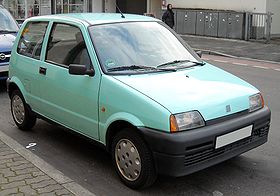Fiat Cinquecento
| Fiat Cinquecento | |
|---|---|
 |
|
| Overview | |
| Manufacturer | Fiat |
| Production | 1991–1998 |
| Assembly | Tychy, Poland |
| Body and chassis | |
| Class | City car (A) |
| Body style | 3-door hatchback |
| Layout | Front-engine, front-wheel-drive |
| Powertrain | |
| Engine | |
| Dimensions | |
| Wheelbase | 2,200 mm (86.6 in) |
| Length | 3,230 mm (127.2 in) 3,226 mm (127.0 in) (Sporting) |
| Width | 1,490 mm (58.7 in) 1,486 mm (58.5 in) (Sporting) |
| Height | 1,435 mm (56.5 in) |
| Kerb weight | 675–727 kg (1,488–1,603 lb) |
| Chronology | |
| Predecessor | Fiat 126 |
| Successor | Fiat Seicento |
The Fiat Cinquecento (Type 170) (/ˌtʃɪŋkwəˈtʃɛntoʊ/; Italian pronunciation: [ˌtʃiŋkweˈtʃɛnto]) is a city car, launched by Fiat in December 1991, to replace the Fiat 126. It was the first Fiat model to be solely manufactured in the FSM plant in Tychy, Poland, which had been sold to Fiat by the Polish state, and where production of the Polish variant of the Fiat 126, the Polski Fiat 126p, was still running.
However, the right-hand drive Cinquecento for the British market was not launched for another 18 months, going on sale there in June 1993, where at the time it was one of the few city cars sold there. The Renault Twingo, launched around the same time as the Cinquecento, was not sold in Britain as Renault did not feel that there was sufficient demand for that type of car there at the time. However, by the end of the 1990s, city cars in Britain - and indeed most of the rest of Europe - were enjoying a rise in popularity, with the arrival of new city cars including the Ford Ka, Seat Arosa and Volkswagen Lupo.
Production of the Cinquecento ended in early 1998, when it was replaced by the Seicento. Despite its name, its lowest displacement was 704 cc. The Cinquecento was available in one body style only, a small, angular 3-door hatchback, with a favourable drag coefficient of only 0.33 that bore similarities to the Lancia Y10.
...
Wikipedia
